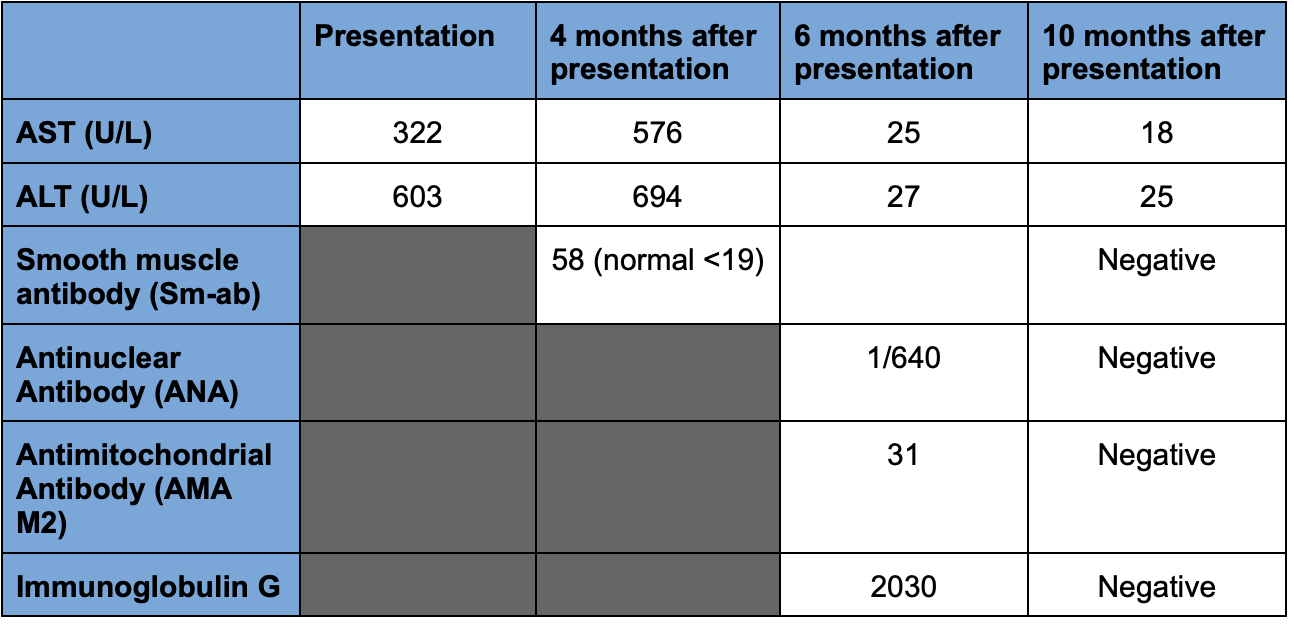Monday Poster Session
Category: Liver
P3909 - Too Much Grapefruit: Drug-Induced Liver Injury Triggered by Fruit Consumption
Monday, October 27, 2025
10:30 AM - 4:00 PM PDT
Location: Exhibit Hall

Cinthia Reyes Cruz, MD
University of Miami Miller School of Medicine at Holy Cross Hospital
Fort Lauderdale, FL
Presenting Author(s)
Cinthia Reyes Cruz, MD1, Wisam Zakko, MD2
1University of Miami Miller School of Medicine at Holy Cross Hospital, Fort Lauderdale, FL; 2Gastroenterology Institute Of Fort Lauderdale, Fort Lauderdale, FL
Introduction: While mild elevation of liver function tests (LFTs) is common with statins, severe drug induced liver injury (DILI) is rare, occurring in 1 to 2% of patients. Statin induced autoimmune hepatitis (SIAIH) is even less common with only isolated case reports published. Most case reports of SIAIH occur weeks to months after starting the drug. We report a case of SIAIH with an onset of 15 years after starting the drug, triggered by consuming grapefruit daily. We postulate that the inhibition of CYP3A4 led to increased drug levels which triggered SIAIH.
Case Description/
Methods: A 68 year old female with a past medical history of depression on duloxetine, hyperlipidemia on long term atorvastatin (ATO) presented to the gastroenterology office due to elevated LFTs. Her initial LFTs are depicted on (Table 1). She had a negative viral hepatitis panel (Table 2). Four months later, LFTs remained elevated with a positive autoimmune marker (Table 1). Liver ultrasound showed fatty liver. At that point all her medications were discontinued. 2 months later, her LFTs normalized and further autoimmune markers were positive (Table 1). On history-taking, she admitted to eating 1-2 grapefruits daily for several months prior to her first abnormal LFTs. 4 months after stopping ATO, LFTs remained normal and autoimmune laboratory tests normalized (Table 1).
Discussion: Drug induced autoimmune hepatitis (DIAH) is a specific type of DILI that can lead to liver failure. DIAIH is idiosyncratic with an unclear mechanism. Latency in DIAIH is variable and can be prolonged. The onset of liver injury in SIAIH is variable and prolonged, similar to other types of DIAIH. On literature review, the onset commonly is within months and up to 18 months in one report. Our patient was on ATO for 15 years with previously normal LFTs.
Our patient’s presentation resembled a typical autoimmune hepatitis with elevated LFTs and positive autoimmune markers. However, the prompt normalization of LFTs and later disappearance of the autoimmune markers following discontinuation of the statin were consistent with DIAIH. The temporal relationship of daily ingestion of grapefruits, a known inhibitor of CYP3A4, suggests that increased levels of ATO was responsible for the DIAH and prolonged latency. This underscores the importance of considering DILI on patients who have previously had normal LFTs on a medication for many years. We highlight the need for thorough history-taking including dietary habits that could lead to important interactions.

Figure: Table 1. Liver function test trend and autoimmune laboratory workup

Figure: Table 2. Viral hepatitis panel
Disclosures:
Cinthia Reyes Cruz indicated no relevant financial relationships.
Wisam Zakko indicated no relevant financial relationships.
Cinthia Reyes Cruz, MD1, Wisam Zakko, MD2. P3909 - Too Much Grapefruit: Drug-Induced Liver Injury Triggered by Fruit Consumption, ACG 2025 Annual Scientific Meeting Abstracts. Phoenix, AZ: American College of Gastroenterology.
1University of Miami Miller School of Medicine at Holy Cross Hospital, Fort Lauderdale, FL; 2Gastroenterology Institute Of Fort Lauderdale, Fort Lauderdale, FL
Introduction: While mild elevation of liver function tests (LFTs) is common with statins, severe drug induced liver injury (DILI) is rare, occurring in 1 to 2% of patients. Statin induced autoimmune hepatitis (SIAIH) is even less common with only isolated case reports published. Most case reports of SIAIH occur weeks to months after starting the drug. We report a case of SIAIH with an onset of 15 years after starting the drug, triggered by consuming grapefruit daily. We postulate that the inhibition of CYP3A4 led to increased drug levels which triggered SIAIH.
Case Description/
Methods: A 68 year old female with a past medical history of depression on duloxetine, hyperlipidemia on long term atorvastatin (ATO) presented to the gastroenterology office due to elevated LFTs. Her initial LFTs are depicted on (Table 1). She had a negative viral hepatitis panel (Table 2). Four months later, LFTs remained elevated with a positive autoimmune marker (Table 1). Liver ultrasound showed fatty liver. At that point all her medications were discontinued. 2 months later, her LFTs normalized and further autoimmune markers were positive (Table 1). On history-taking, she admitted to eating 1-2 grapefruits daily for several months prior to her first abnormal LFTs. 4 months after stopping ATO, LFTs remained normal and autoimmune laboratory tests normalized (Table 1).
Discussion: Drug induced autoimmune hepatitis (DIAH) is a specific type of DILI that can lead to liver failure. DIAIH is idiosyncratic with an unclear mechanism. Latency in DIAIH is variable and can be prolonged. The onset of liver injury in SIAIH is variable and prolonged, similar to other types of DIAIH. On literature review, the onset commonly is within months and up to 18 months in one report. Our patient was on ATO for 15 years with previously normal LFTs.
Our patient’s presentation resembled a typical autoimmune hepatitis with elevated LFTs and positive autoimmune markers. However, the prompt normalization of LFTs and later disappearance of the autoimmune markers following discontinuation of the statin were consistent with DIAIH. The temporal relationship of daily ingestion of grapefruits, a known inhibitor of CYP3A4, suggests that increased levels of ATO was responsible for the DIAH and prolonged latency. This underscores the importance of considering DILI on patients who have previously had normal LFTs on a medication for many years. We highlight the need for thorough history-taking including dietary habits that could lead to important interactions.

Figure: Table 1. Liver function test trend and autoimmune laboratory workup

Figure: Table 2. Viral hepatitis panel
Disclosures:
Cinthia Reyes Cruz indicated no relevant financial relationships.
Wisam Zakko indicated no relevant financial relationships.
Cinthia Reyes Cruz, MD1, Wisam Zakko, MD2. P3909 - Too Much Grapefruit: Drug-Induced Liver Injury Triggered by Fruit Consumption, ACG 2025 Annual Scientific Meeting Abstracts. Phoenix, AZ: American College of Gastroenterology.
